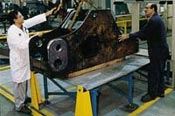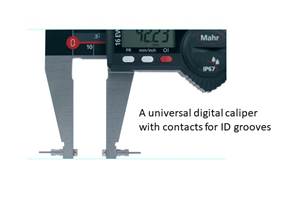Truck-Chassis Quality Throughput Upgraded With Shopfloor Coordinate Measuring
CMMs, once relegated to protected, off-the-floor QA labs, are now proving out in manufacturing environments such as heavy-metal fabrication shops. The payoff is the same as in precision manufacturing: higher yields, better process control and lower inspection costs.
Share





CMMs, once relegated to protected, off-the-floor QA labs, are now proving out in manufacturing environments such as heavy-metal fabrication shops. The payoff is the same as in precision manufacturing: higher yields, better process control and lower inspection costs.
Case in point is Mancor Industries (Oakville, Ontario, Canada), an ISO 9002-certified fabricator of chassis components for the global truck market. Mancor plants used to use caliper or indicator inspection or off-the-floor CMMs for inspection of its chassis parts. Back then, a run of new parts had to await the blessing from a small team of first-shift inspectors.
Mancor was familiar with using CMMs on the shop floor because it had used them at other plants and seen an increase in throughput, so the company looked into CMMs for the Oakville plant. Mancor compared four different CMMs and one computer-activated measuring arm. The main criteria were shopfloor compatibilities, size capacity, programming and measuring ease, travel and acceleration speeds, cost, training, support and service. The unit that best met Mancor’s needs was a Mitutoyo Bright Apex 1230 CNC/CMM from Mitutoyo (Aurora, Illinois) with GEOMeasure 6000 software. “It’s important to compare the software as carefully as the hardware, and accelerations as carefully as speeds,” says Luis Vitorino, manager of corporate quality. “There are big differences among CMMs on these two scores. Both will make a huge difference in overall inspection throughput. Successful experience with Mitutoyo CMMs in other plants certainly also helped in our decision, though this is the largest model we’ve ever purchased.”
So the new Bright Apex CNC/CMM was installed in February 1999. Because Mancor’s fabrication operations inevitably generate some dust, it built a Plexiglas enclosure around the CMM to keep the surfaces clean. “The enclosure is not necessary for stability or functionality of the CMM,” he explains. “We added it to simplify housecleaning and to keep the worktable surface cleaner.”
Right now, the plant is midway through the transformation. Regular inspectors still do most of the measurements and programming, and they have begun training operators to do their own inspections. Some operators have already begun some of the simpler parts, especially on second and third shifts. The company has already seen improvement. “Though the parts we make may be large, lot sizes are small,” says Mr. Vitorino. “When we can start a new run sooner, we can finish it sooner. Especially in small-lot operations, debottlenecking the first-piece inspection directly benefits plant capacity regardless of how big or small the workpiece is.” He added that ability to start any job on any shift, without having to wait for an inspector, will materially benefit scheduling.
With 500 part families in the Oakville plant’s portfolio and a three-shift operation, Mancor has a lot of protocols to write and training to do. Typical parts Mancor manufactures at Oakville are cross-members, brackets, suspension components, bolster assemblies and miscellaneous chassis supports. Most workpieces are long, heavy, and match-fitted to other chassis parts. Therefore, both dimensional and positional accuracy are critical.
Lot sizes may run from one to 20, averaging less than 50. One large part might take a full shift to make, while smaller parts are done in a couple of production hours. The raw stock, formed or cast usually from plate steel, first passes through Receiving, where it is pre-inspected for size and dimensional accuracy. Once approved, shop operators plasma or laser cut the part to length, form and weld it, then transfer it to machining, where it undergoes milling, drilling and other CNC machining operations.
Each part typically requires 50 measurements, including size, depth, absolute position and relative position. Tolerances are ±0.002 inch.
A typical part is a base for lifting devices used in repair work measuring 5 feet long by 2 feet wide. It has a total of 20 holes, ten on each side. When the first piece comes off the drilling and milling operation, inspectors measure it for straightness, linear distance, thickness, hole diameter, depth and true position. Parts are loaded outside the enclosure and conveyed on rails to the measuring table.
Measuring this base, which used to take half an hour, now takes ten minutes with the new CMM. The measurements are also more consistently accurate and reliable, since all the data points are generated automatically. And since the CMM automatically generates an inspection record, documentation takes literally no time. The document travels with the job, freeing the customer from having to run any incoming-part inspections.Programming inspection of new parts is easy. Inspectors write the programs with the aid of the Bright Apex 1230 CNC/CMM’s general-purpose GEOMeasure 6000 software, which is Windows compatible. A joystick box that comes standard with the CMM facilitates component verification and easy creation of part programs. As the user performs the inspection in LEARN mode, steps are recorded in memory for future replay. When that part is ready for inspection next time, he calls up the part program and presses the RUN button. The CMM does it all automatically, hands-off. Then, it compares readings to known values embedded in the part program and gives a pass/fail result and diagnostics.
Mancor-Oakville has seen a threefold increase in inspection throughput even though it is still in transition. Rather than having to wait 20 minutes to half an hour for the OK to start a new job, now machine operators get the word within minutes. Overall plant throughput is beginning to benefit accordingly. “Based on my experience at our other facilities, we should be ready to fully transfer inspection of all our parts to the shop floor within six to eight months,” says Mr. Vitorino. MMS
Related Content
Choosing the Correct Gage Type for Groove Inspection
Grooves play a critical functional role for seal rings and retainer rings, so good gaging practices are a must.
Read MoreThe Many Ways of Measuring Thickness
While it may seem to be a straightforward check, there are many approaches to measuring thickness that are determined by the requirements of the part.
Read MoreParts and Programs: Setup for Success
Tips for program and work setups that can simplify adjustments and troubleshooting.
Read MoreOrthopedic Event Discusses Manufacturing Strategies
At the seminar, representatives from multiple companies discussed strategies for making orthopedic devices accurately and efficiently.
Read MoreRead Next
Setting Up the Building Blocks for a Digital Factory
Woodward Inc. spent over a year developing an API to connect machines to its digital factory. Caron Engineering’s MiConnect has cut most of this process while also granting the shop greater access to machine information.
Read More5 Rules of Thumb for Buying CNC Machine Tools
Use these tips to carefully plan your machine tool purchases and to avoid regretting your decision later.
Read MoreRegistration Now Open for the Precision Machining Technology Show (PMTS) 2025
The precision machining industry’s premier event returns to Cleveland, OH, April 1-3.
Read More.png;maxWidth=970;quality=90)





















.png;maxWidth=300;quality=90)




.jpg;maxWidth=300;quality=90)








